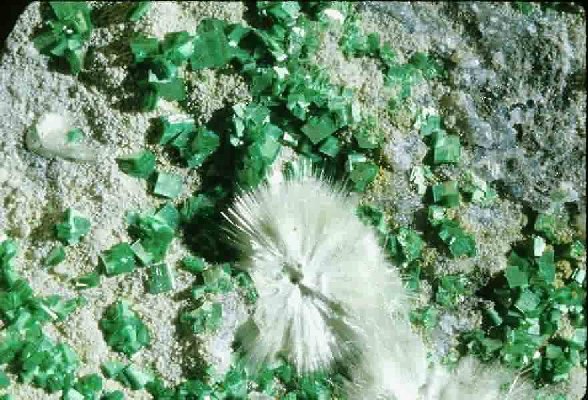

|
The Black Hills of South Dakota, USA are known for its variety of minerals
from pegmatites and gold/silver vein deposits. In fact, in the late 1800's
people would refer to the Black Hills as the richest mineralized mining camp
in the world. Many famous mines are located in the Black Hills including
the Homestake gold mine still in operation after 120 years. For the mineral
collector, such mines as the Tiptop mine, Bull Moose, Big Chief host rare
species not matched anywhere in the world. World class golden barite is
found outward from the Black Hills also. In March of 1996, a mineral called
Sincosite was found at the Ross Hannibal mine near Lead, South Dakota by Tom
Loomis. The find of sincosite was said to have been the best sincosite ever found. Only 4 or five other localities are known including the type localty in Sincos, Peru. The other localities however feature inferior quaility and very minute crystals. The Ross Hannbal mine features crystals up to 7mm (rare) and average 3mm in size. The crystals are grass green to "torbernite" green. The sincosite from the Ross Hannibal was mistaken for Torbernite in the late 1890's. If not for this, the Ross Hannibal would have become the type locality. Sincosite is a rare hydrated calcium vanadyl-phosphate and was first described by Schaller in 1924. SEM and XRD analysis have confirmed the identification of sincosite from the Ross Hannibal. Featured below is sincosite with minyulite.  In addition to sincosite, another mineral called minyulite was found as fine, acicular white sprays. This occurance marked the second in North America and the fourth in the world. Hessite, silver telluride, is also associated with sincosite in very rare, less than 1mm crystals. The Ross Hannibal mine was operated by the Golden Reward Mining Company. The mine has been closed due to lack of economic gold ore and the deposit has been backfilled and reclaimed. The gold bearing strata in which the sincosite occurs is lower Deadwood Formation of Cambrian age. In this locality the Deadwood Fm is a sandstone with intense pyritization and silicification. Fluorite occurs surrounding the sincosite zone is not associated with it. The author collected about 100 flats of the material before the deposit was engulfed by spring run-off and later backfilling. Specimens are still available from Dakota Matrix Minerals at http://www.dakotamatrix.com or email Tom Loomis at tloomis1@oasisol.com . |